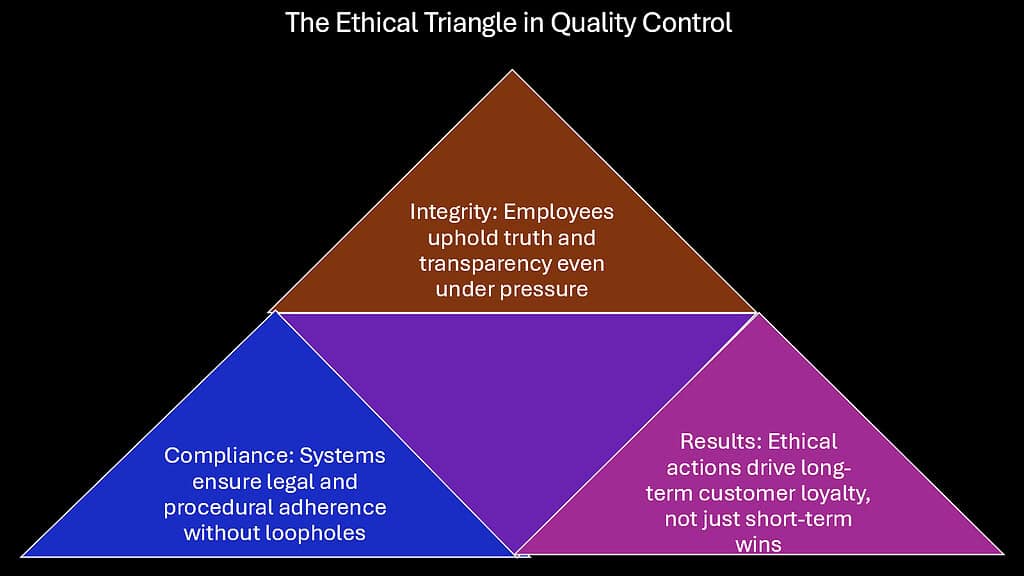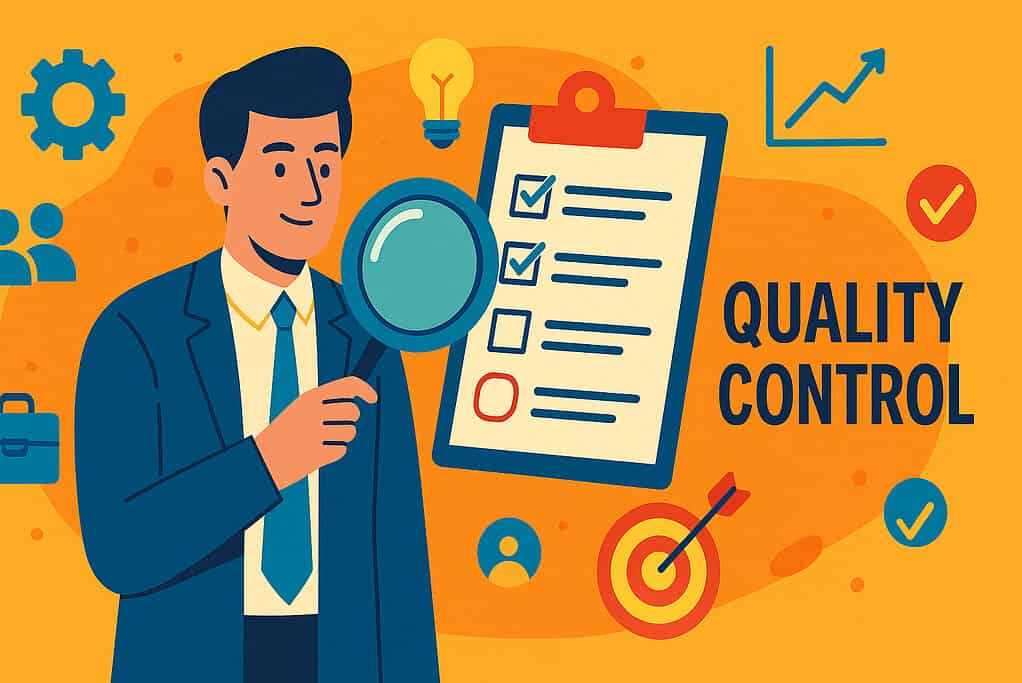Table of Contents
Introduction: The Human Pulse of Quality Control

Quality control has traditionally been part of operations. Conventionally, it is viewed as a mechanical process involving a series of checkpoints, measurements, and statistical analyses. However, beneath this technical exterior lies a fundamentally human endeavor. Even the most advanced quality management systems ultimately rely on human attributes such as attention, emotional intelligence, and professional pride. Although significant progress has been made in automating quality control processes, the psychological aspects of QC remain both its greatest weakness and its most significant strength.
Consider how quickly a distracted inspector can miss a critical defect, or how a team’s collective sense of ownership can dramatically improve output quality. These human factors aren’t peripheral to quality control – they are its foundation. As manufacturing and service industries continue evolving toward greater automation, understanding the psychological aspects of quality control becomes not just helpful but essential.
The psychology of quality control isn’t merely academic theory. Organizations that recognize and nurture these human elements consistently outperform those focused exclusively on technical specifications and statistical process control. According to research from the American Society for Quality, companies that address the psychological dimensions of quality work see defect rates decrease by approximately 30% compared to those using purely technical approaches.
This article explores six critical psychological aspects that separate mediocre quality control from exceptional quality assurance. From the focused attention of flow states to the ethical foundations that build customer trust, these elements form the human core of effective quality management.
| Psychological Dimension | Impact on Quality Control | Key Challenge | Strategic Opportunity |
|---|---|---|---|
| Attention & Flow | Reduces errors, improves precision | Maintaining consistent focus | Creating environments conducive to deep work |
| Discipline & Consistency | Establishes reliable processes | Avoiding complacency | Building sustainable quality habits |
| Intrinsic Motivation | Drives ownership and initiative | Overcoming extrinsic reward limitations | Aligning quality with personal values |
| Emotional Resilience | Sustains performance under pressure | Preventing burnout | Converting criticism into improvement |
| Ethical Commitment | Builds stakeholder trust | Balancing speed with integrity | Making quality a moral imperative |
| Cognitive Load Management | Optimizes decision-making | Addressing mental fatigue | Designing systems that support human cognition |
1. Quality Control and Attention to Detail: The Flow State Effect
The concept of “flow” – that elusive state of complete absorption in a task – represents the gold standard for quality control work. First described by psychologist Mihaly Csikszentmihalyi, flow occurs when people become so immersed in their work that time seems to distort, distractions fade, and performance reaches optimal levels. For quality control professionals, achieving flow creates the perfect conditions for detecting even the subtlest defects or inconsistencies.
When quality inspectors achieve flow states, their focus sharpens, enabling them to process visual information with exceptional accuracy. This increased awareness allows them to detect patterns and irregularities that might otherwise be overlooked. Organizations that recognize this psychological phenomenon can create quality control environments that facilitate, rather than obstruct, these optimal states of consciousness.
Companies like Toyota have long recognized the importance of flow states in quality inspection. Their “andon cord” system, which allows any worker to stop production when they spot a quality issue, acknowledges that human attention is most valuable when it can be fully devoted to the task at hand. By eliminating the cognitive load of deciding whether to report a problem, Toyota creates space for workers to remain in flow states longer.
The challenge for quality managers lies in fostering these conditions consistently. Flow requires the right balance of challenge and skill – work that is neither too easy (causing boredom) nor too difficult (causing anxiety). It also demands clear goals, immediate feedback, and protection from interruptions. Quality control teams that achieve these conditions consistently report not just higher accuracy, but also greater job satisfaction and lower employee turnover.
| Flow State Component | Application to Quality Control | Implementation Strategy |
|---|---|---|
| Clear Goals | Precise understanding of inspection criteria | Detailed visual standards and examples of acceptable vs. unacceptable quality |
| Immediate Feedback | Quick confirmation of detected defects | Calibration samples and verification systems |
| Balanced Challenge | Tasks that stretch but don’t overwhelm inspectors | Adaptive training programs that match complexity to skill level |
| Freedom from Interruptions | Unbroken concentration during inspection periods | Dedicated inspection areas with minimal distractions |
| Skill-Challenge Balance | Matching inspector expertise to appropriate tasks | Progressive responsibility based on demonstrated capability |
| Sense of Control | Autonomy in determining inspection pace and method | Flexible workflows that accommodate individual inspection styles |
2. Quality Control Through Discipline: Why Consistency Beats Brilliance

In the realm of quality control, disciplined consistency proves more valuable than occasional brilliance. This principle contradicts our culture’s celebration of genius and innovation, yet becomes evident in any sustained quality improvement effort. The most reliable quality systems depend not on flashes of insight but on the steady application of proven methods, day after day, regardless of circumstances.
Quality control is fundamentally a practice of habit formation. The disciplined inspector who methodically follows the same verification sequence every time catches more defects than the brilliant technician who relies on intuition but skips steps when rushed. Similarly, organizations that maintain consistent documentation and regularly scheduled calibration prevent more quality issues than those that implement occasional but dramatic quality initiatives.
Manufacturing leaders like W. Edwards Deming recognized this truth decades ago when he emphasized that quality comes from improvement of the process, not from inspection alone. The discipline to follow standardized work instructions, complete checklists, and maintain calibration schedules creates a foundation upon which quality can consistently stand.
The psychological challenge lies in maintaining this discipline despite the human tendency toward variability. Quality control professionals must resist both complacency during routine tasks and corner-cutting during high-pressure periods. Organizations can support this discipline through accountability structures, visual management, and recognition systems that reward consistency rather than just firefighting.
| Discipline Component | Quality Control Application | Example Practice |
|---|---|---|
| Routine Adherence | Following inspection protocols regardless of perceived urgency | Standardized work instructions with visual aids |
| Preventive Maintenance | Regular calibration and verification of equipment | Time-based maintenance schedules with accountability |
| Documentation Habits | Consistent record-keeping of inspection results | Simple, accessible documentation systems |
| Feedback Loops | Regular review of quality data to identify patterns | Daily quality meetings with visual management boards |
| Trigger-Based Behaviors | Automatic responses to specific quality signals | Response protocols for out-of-specification conditions |
| Intentional Improvement | Scheduled time for process optimization and refinement | Weekly kaizen activities focused on quality processes |
3. Motivation in Quality Control: Driving Internal Pride, Not External Pressure
The psychological drive behind quality control efforts significantly impacts their effectiveness. According to Self-Determination Theory developed by psychologists Edward Deci and Richard Ryan, sustainable motivation stems from satisfying three core psychological needs: autonomy (self-direction), competence (mastery), and relatedness (meaningful connection). When quality control systems align with these needs, they cultivate internal motivation that far outlasts external pressure.
External motivators like quality bonuses or punitive measures for defects can drive short-term compliance but often undermine long-term quality commitment. Quality professionals working primarily to avoid punishment or earn rewards typically perform verification tasks with minimal engagement, missing subtle signals that might indicate emerging problems. Conversely, teams motivated by professional pride, customer impact awareness, and skill development tend to approach quality control with genuine investment.
Companies like Lexus exemplify this principle through their quality control methodology, which prioritizes craftsman-like pride over the avoidance of punishment. By linking quality inspection to the Japanese concept of ‘takumi’ (mastery through dedication), Lexus has fostered a culture where identifying potential problems is seen as a source of professional fulfillment rather than a burdensome obligation.
The challenge for quality managers lies in transitioning from purely compliance-based approaches to systems that nurture intrinsic motivation. This shift requires giving quality control teams greater autonomy in developing inspection methods, opportunities to build expertise, and direct connection with the end-users of their products or services.
| Self-Determination Element | Quality Control Application | Implementation Approach |
|---|---|---|
| Autonomy | Control over inspection methods | Involvement in quality procedure development |
| Competence | Progressive skill development | Multi-level certification programs |
| Relatedness | Connection to product impact | Customer feedback sharing and site visits |
| Purpose | Understanding quality significance | Transparency about defect consequences |
| Recognition | Acknowledgment of quality contributions | Celebration of prevented issues, not just zero defects |
| Growth | Continuous learning opportunities | Cross-training and advanced quality education |
4. Emotional Resilience and Burnout in Quality Control Roles
Quality control positions impose unique psychological burdens that can significantly impact performance over time. By definition, quality inspectors focus on finding problems – spending their days identifying defects, deviations, and errors. This constant exposure to negative findings can create a psychological strain that manifests as cynicism, hypervigilance, or emotional exhaustion if not properly managed.
The phenomenon known as “inspection fatigue” represents a specific form of burnout that affects quality professionals. Unlike general workplace burnout, inspection fatigue specifically impacts perceptual accuracy and decision-making consistency. Quality control specialists experiencing this condition may alternate between missing obvious defects and raising false alarms about acceptable variations. Research from manufacturing environments suggests that inspection accuracy can decline by up to 28% during extended quality control shifts without proper intervention.
Organizations like 3M have addressed this challenge by implementing rotation systems that alternate inspection tasks with other responsibilities. This approach recognizes that emotional resilience in quality control requires periodic relief from the psychological burden of constant fault-finding. Similarly, companies like Bosch have developed targeted resilience training programs specifically for quality personnel, teaching techniques for maintaining emotional equilibrium while performing critical verification tasks.
The path to sustainable quality control performance requires acknowledging these psychological realities rather than expecting superhuman concentration. Effective quality systems incorporate regular mental recovery periods, build supportive team environments, and provide tools for managing the natural emotional responses to repetitive inspection work.
| Resilience Factor | Quality Control Application | Organizational Support Mechanism |
|---|---|---|
| Recovery Periods | Scheduled breaks during inspection shifts | Microbreak systems with visual/auditory reminders |
| Cognitive Variety | Task rotation to avoid perceptual fatigue | Mixed-responsibility work design |
| Social Support | Team-based quality verification | Collaborative inspection procedures |
| Success Recognition | Acknowledgment of prevented problems | Tracking of “good catches” alongside defect metrics |
| Meaning Connection | Understanding impact of quality work | Customer feedback sharing and product lifecycle visibility |
| Physical Environment | Workspace design supporting sustained attention | Ergonomic inspection stations with natural light |
5. Ethical Commitment in Quality Control: Trust as the Ultimate Output

Beyond specifications and measurements, quality control ultimately produces something more fundamental: trust. The ethical dimension of quality work represents perhaps its most profound psychological aspect, linking individual inspection decisions to organizational integrity and customer wellbeing. The Ethical Triangle framework – balancing integrity, compliance, and results – offers a powerful lens for understanding how quality control functions as moral practice.
Quality control professionals regularly face ethical tensions between competing priorities. The pressure to meet production targets can conflict with thoroughness. Loyalty to colleagues may clash with the responsibility to report problems. The desire to protect the organization’s reputation might compete with transparency about discovered issues. These tensions create psychological stress that, if unaddressed, can erode quality effectiveness.
Organizations like Johnson & Johnson demonstrate how ethical clarity strengthens quality control. Their handling of the 1982 Tylenol tampering crisis – recalling every product despite no corporate fault – established an ethical benchmark for quality decisions. This ethical foundation has since been formalized in many organizations through quality policies that explicitly acknowledge the moral dimensions of inspection work.
The psychological power of ethical commitment lies in its ability to transform quality control from mere verification to meaningful stewardship. When quality professionals view their work as protecting end-users rather than just following procedures, their attentiveness and thoroughness naturally increase. Companies that cultivate this ethical awareness in quality teams consistently outperform those that focus exclusively on technical compliance.
| Ethical Triangle Element | Quality Control Application | Implementation Strategy |
|---|---|---|
| Integrity | Consistent application of standards regardless of pressure | Ethics training specific to quality scenarios |
| Compliance | Adherence to regulations and procedures | Clear documentation of non-negotiable requirements |
| Results | Meeting business performance targets | Balanced scorecards integrating quality and production metrics |
| Transparency | Honest communication about quality issues | Non-punitive problem reporting systems |
| Stakeholder Consideration | Balance of multiple interests in quality decisions | Decision frameworks accounting for all affected parties |
| Courage | Willingness to make difficult quality calls | Recognition of ethical leadership in quality matters |
6. Cognitive Load and Focus Fatigue in Quality Control Tasks
Quality control work puts extraordinary demands on human cognition. Every inspection requires sustained attention, working memory application, and complex decision-making, often under time pressure. Cognitive load theory explains why mental fatigue becomes a critical factor in quality performance, particularly for tasks requiring visual discrimination or detailed analysis.
As cognitive resources become depleted, quality control inspectors experience predictable changes in performance. Their ability to notice subtle deviations decreases, decision-making slows, and tolerance for ambiguity diminishes. These effects explain why defect detection rates often decline over the course of a shift, with studies from electronics manufacturing showing error detection dropping by up to 15% in the final hours compared to early shift performance.
Companies like Intel have addressed this challenge by redesigning quality control workflows to accommodate cognitive limitations. Their “micro-break” system introduces brief, structured mental recovery periods that maintain cognitive freshness throughout inspection shifts. Similarly, Japanese automotive suppliers have pioneered “poka-yoke” (mistake-proofing) approaches that reduce cognitive burden by making correct inspection physically easier than incorrect inspection.
The most effective quality control systems acknowledge that human cognition has finite capacity and design accordingly. Rather than expecting superhuman concentration, they create environments that distribute cognitive load appropriately, provide recovery opportunities, and leverage technology to compensate for natural mental fatigue.
| Cognitive Load Factor | Quality Control Implication | Mitigation Strategy |
|---|---|---|
| Working Memory Limits | Difficulty tracking multiple inspection criteria | Visual reference guides and checklists |
| Attention Fatigue | Declining detection rates over time | Scheduled rotation and micro-breaks |
| Decision Fatigue | Inconsistent application of inspection standards | Decision support tools and clear go/no-go criteria |
| Perceptual Narrowing | Missing peripheral or contextual issues | Structured scanning patterns and mnemonic devices |
| Information Overload | Inability to process excessive data | Prioritized information display and filtering |
| Vigilance Decrement | Declining alertness during repetitive tasks | Varied task scheduling and environmental changes |
Conclusion: Keeping the Soul in the System of Quality Control

Quality control represents far more than technical verification – it embodies an organization’s commitment to excellence, integrity, and human consideration. As we’ve explored throughout this article, the psychological dimensions of quality work critically determine its effectiveness. Organizations that address these human factors create quality systems that are not just mechanically sound but psychologically sustainable.
The six psychological aspects we’ve examined – flow states, discipline, intrinsic motivation, emotional resilience, ethical commitment, and cognitive load management – form an integrated foundation for operational excellence. Each dimension reinforces the others, creating a psychological ecosystem where exceptional quality becomes not just possible but natural. Companies that nurture these elements consistently outperform those relying solely on technical tools or statistical methods.
As technology continues transforming quality control through automation, artificial intelligence, and advanced analytics, the human elements actually grow in importance rather than diminish. The judgment, intuition, and ethical reasoning that humans bring to quality decisions remain irreplaceable, particularly for complex evaluations or nuanced quality situations. The most effective quality systems integrate technological capabilities with human psychological strengths rather than attempting to eliminate the human component.
For quality professionals and leaders, the path forward lies in appreciating quality control as fundamentally psychological work. By designing systems that support human cognitive and emotional needs, organizations create sustainable quality cultures that consistently deliver excellence. The future of quality control doesn’t lie in removing the human element, but in understanding and nurturing the psychological soul within the system.
| Psychological Dimension | Key Takeaway | Implementation Priority |
|---|---|---|
| Attention & Flow | Quality thrives in states of focused immersion | Creating distraction-free inspection environments |
| Discipline & Consistency | Reliable processes depend on habitual excellence | Building quality habits through structured routines |
| Intrinsic Motivation | Sustainable quality stems from internal drive | Connecting quality work to meaningful purpose |
| Emotional Resilience | Quality roles require managed emotional energy | Preventing burnout through supportive systems |
| Ethical Commitment | Trust emerges from principled quality decisions | Establishing clear ethical frameworks for quality |
| Cognitive Management | Mental fatigue directly impacts quality outcomes | Designing inspection work around cognitive limitations |




